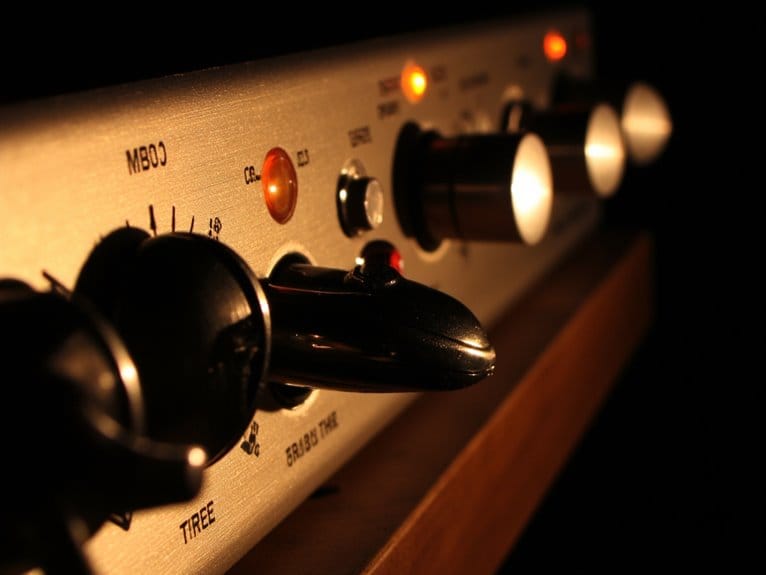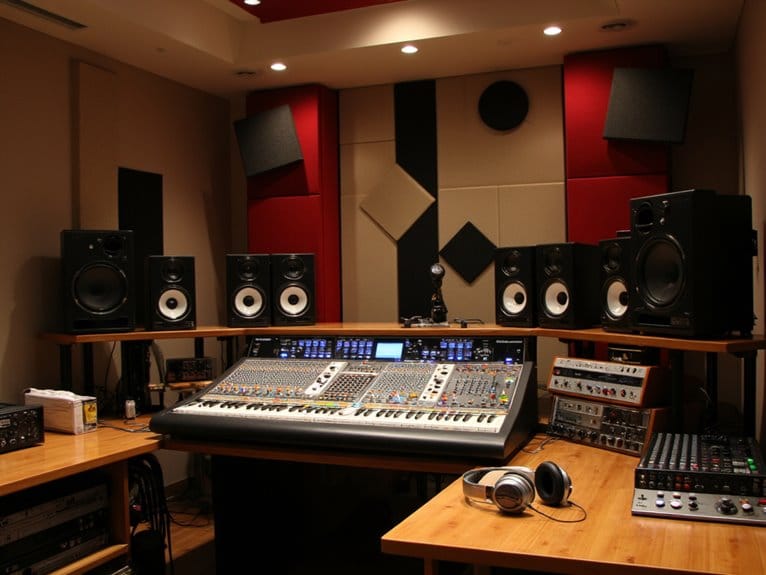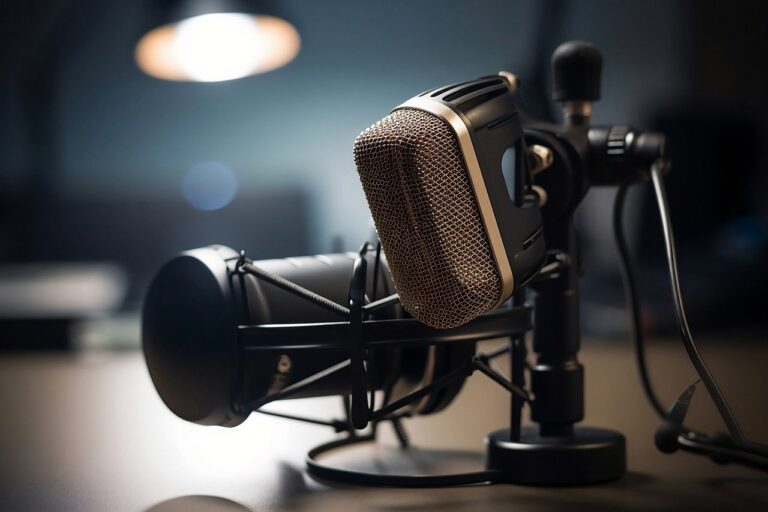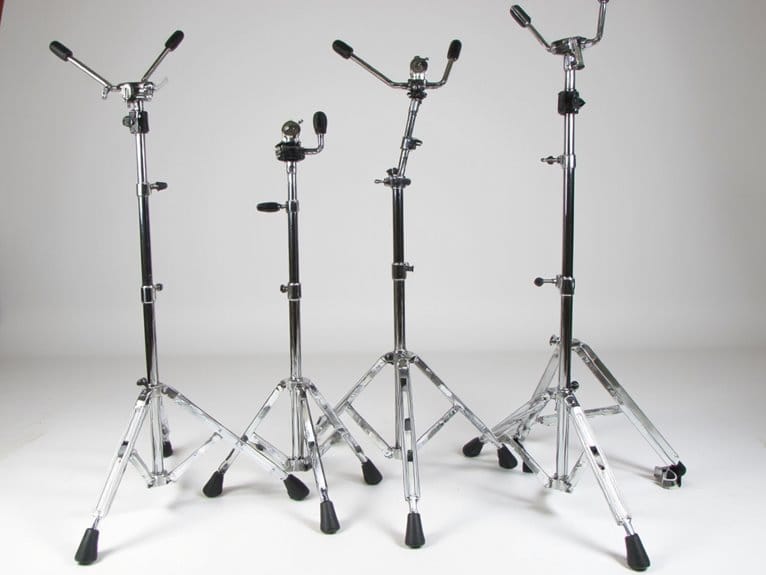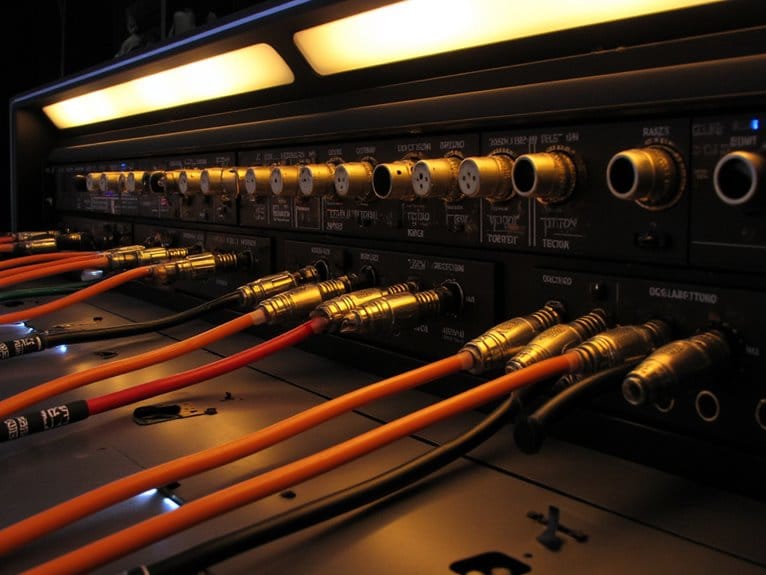Bass Amplifier EQ and Tone Shaping Techniques
You’ll master bass amplifier EQ by understanding how each frequency band shapes your sound, starting with bass controls (40-150 Hz) for weight, midrange (250-750 Hz) for punch and clarity, and treble (above 3 kHz) for attack and brightness. The popular scooped mid technique involves cutting mids to 3-4 while moderately boosting bass and treble, though clean tones benefit from flat settings around 5 with slight mid cuts to 4. Different genres require specific approaches—country needs twangy brightness, metal demands aggressive scooped mids, while jazz emphasizes warm midrange frequencies, and there’s much more to explore about surgical cuts and dynamic EQ applications.
We are supported by our audience. When you purchase through links on our site, we may earn an affiliate commission, at no extra cost for you. Learn more.
Notable Insights
- Use a four-band EQ system to precisely control bass (40-150 Hz), low-mid, high-mid, and treble (3+ kHz) frequencies.
- Apply the scooped mid technique by reducing midrange to 3-4 while boosting bass and treble for cutting power.
- Start with flat EQ settings at 5, then make subtle adjustments to avoid muddy or harsh tones.
- Tailor your EQ to genre requirements: country needs twangy treble, metal wants scooped mids, jazz emphasizes warm midrange.
- Use surgical EQ cuts and dynamic processing to eliminate frequency resonances and dead spots in your tone.
Understanding Bass Amplifier EQ Bands and Their Functions
The foundation of bass tone shaping begins with understanding your amplifier’s EQ bands, which function as frequency-specific volume controls that either boost or cut predetermined ranges of your instrument’s sound spectrum.
Most bass amps feature either two-band or three-band EQ circuits, with two-band controlling bass and treble frequencies, while three-band adds vital midrange control for enhanced tonal clarity.
The bass band manages low frequencies around 40-150 Hz, affecting your sound’s weight and fullness, while treble controls frequencies above 3 kHz, shaping attack and brightness.
Three-band systems include midrange control covering 200 Hz to several kHz, which directly impacts note definition and presence in the mix. Multiple tone controls provide versatility for various musical styles, allowing bassists to adapt their sound to different genres and performance contexts. Four-band EQ systems further refine your tonal control by breaking mids into separate low-mid and high-mid frequency ranges for more precise sound sculpting.
Understanding your amp’s frequency response characteristics across these bands allows you to sculpt your tone precisely, whether you’re seeking thunderous low-end or crisp articulation. Modern multi-effects processors often include amp simulators that provide additional tonal versatility beyond your amplifier’s built-in EQ capabilities. However, EQ cannot improve fundamental playing skills, as no EQ system can compensate for poor technique or lack of proficiency.
Mastering the Scooped Mid EQ Technique
Sculpting your bass tone through the scooped mid technique transforms your amplifier’s natural voice into something distinctly more aggressive and defined.
Though I’ll admit it’s one of those love-it-or-hate-it approaches that divides bassists into passionate camps. This frequency management strategy emphasizes your instrument’s low-end punch and high-frequency brightness while deliberately reducing midrange presence, creating enhanced articulation that cuts through dense mixes with remarkable tonal clarity.
Here’s your roadmap for implementing scooped mids effectively:
- Start with neutral EQ settings, then gradually reduce your mid knob to 3-4 to maintain note definition
- Boost bass frequencies moderately for fullness while avoiding muddy low-end buildup
- Increase treble to provide brightness and cutting power through complex arrangements
- Target specific frequency ranges—lower mids around 250Hz versus upper mids near 800Hz—for different tonal characteristics
Just as guitarists rely on higher gear ratios for precise tuning adjustments, bassists need equally precise frequency control to achieve the exact tonal balance that complements their playing style and musical context.
Essential EQ Settings for Clean and Balanced Bass Tone
While scooped mids can deliver that aggressive edge some bassists crave, I’ve found that most musical situations actually benefit from a more balanced approach that preserves your instrument’s natural voice without sacrificing clarity or punch.
Start with all EQ controls at their flat 5 setting, which maintains the fundamental relationships between frequencies without artificial coloring. For tonal adjustments, keep bass frequencies around 5 for solid low-end foundation, avoid excessive boosting below 100 Hz to prevent muddiness, and consider slight midrange cuts to 4 for enhanced clarity.
Boost treble slightly to 6 for added presence and articulation, while rolling off frequencies above 7kHz eliminates unwanted noise and improves headroom in your overall mix. Instruments constructed with solid woods like alder or maple will naturally enhance resonance and provide better tonal depth when applying these EQ settings. Remember that your choice of pickup configuration significantly impacts your starting tonal foundation, as different pickup types offer varying levels of versatility before you even touch the EQ controls.
Controlling Frequency Resonances and Dead Spots
Even after achieving that balanced foundation tone we discussed, you’ll inevitably encounter certain notes that ring out excessively while others seem to disappear into thin air, creating an uneven playing experience that can frustrate even seasoned bassists.
Even seasoned bassists struggle when certain notes ring excessively while others vanish, creating frustrating uneven tone across the fretboard.
For effective resonance identification, I recommend sweeping a bell-shaped EQ boost through your bass range, listening carefully for frequencies that create unwanted ringing or sustain. Once you’ve pinpointed these problem areas, dynamic attenuation becomes your best friend, allowing targeted cuts that only engage when those frequencies become excessive.
- Apply surgical EQ cuts to narrow frequency dips without affecting overall character
- Use dynamic EQ with sidechain triggers to prevent kick drum frequency masking
- Adjust amplifier low-frequency resonance controls to match your musical key
- Combine dynamic and passive EQ styles for thorough resonance suppression
Consider incorporating compression pedals with true bypass circuitry into your signal chain, as they can smooth out these dynamic inconsistencies while preserving your natural bass tone when disengaged.
Genre-Specific Tone Shaping and Dynamic EQ Applications
Once you’ve mastered the fundamentals of frequency control, I find that different musical genres demand distinctly different approaches to bass tone shaping, and understanding these stylistic requirements can transform your amplifier from a simple volume box into a genre-specific tone machine.
Country bassists benefit from clean, twangy tones with moderate bass settings and boosted treble for characteristic brightness, while metal players require aggressive high-gain configurations with scooped mids to cut through heavy distortion.
Jazz emphasizes warmer, rounder tones through enhanced midrange frequencies, and funk demands bright, percussive attack with restrained low-end to prevent muddiness. Many modern bass amplifiers feature 4-band EQ systems that provide precise treble, middle, bass, and presence adjustments for detailed frequency sculpting across these diverse musical styles.
Modern dynamic EQ systems automatically adjust these genre tweaks, applying frequency-dependent compression and adaptive midrange control to maintain consistent tonal adjustments regardless of your playing dynamics.
Professional bass amplifiers with multiple channels provide the flexibility to store and switch between these genre-specific EQ configurations during live performances or recording sessions.
Frequently Asked Questions
How Do Room Acoustics Affect My Bass Amplifier’s EQ Settings?
Room reflections dramatically alter your bass amp’s frequency response. Hard surfaces create boomy low-end requiring bass cuts, while absorptive rooms need bass boosts. You’ll adjust EQ opposite to what the room emphasizes.
What’s the Difference Between Analog and Digital EQ Processing for Bass?
Analog EQ adds warmth through harmonic coloration and nonlinearities, giving your bass punch and character. Digital clarity offers precise, clean filtering with complex parametric controls, recall capabilities, and minimal distortion for surgical tone shaping.
How Do I Match My Bass EQ With Different Cabinet Configurations?
Adjust your EQ based on cabinet size and frequency response characteristics. Boost lows cautiously on smaller cabs, cut harsh mids/highs when combining multiple cabinets, and monitor speaker limits to prevent damage.
Should I Use Compression Before or After EQ in My Signal Chain?
You’ll want compression before EQ in your signal flow for most compression types. This stabilizes dynamics first, then lets you shape tone without affecting how the compressor reacts to frequency changes.
On a final note
You’ve now got the fundamental tools to shape your bass tone effectively, from understanding each EQ band’s impact on your overall sound to applying genre-specific techniques that cut through any mix. Remember, your ears are the ultimate judge—trust them over preset recommendations, experiment with different approaches, and don’t be afraid to make bold EQ moves when the music demands it for maximum sonic impact.

